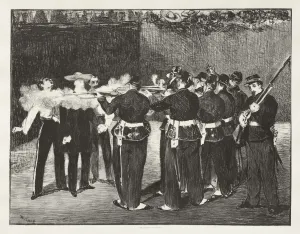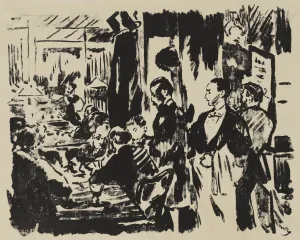Manet
Édouard Manet (1832–1883)
Boy with a Dog, from the portfolio Eight Etchings by Manet, 1862
Etching and aquatint on cream laid paper
Sheet: 14 1/16 x 10 3/8 in. (35.7 x 26.3 cm)
Sterling and Francine Clark Art Institute, Williamstown, Massachusetts, 1962.79
One of eight sheets that formed part of Manet’s first portfolio of prints, this work is based on a drawing probably made from life several years earlier. The subject is the artist’s young assistant and occasional model Alexandre, who committed suicide in his studio in 1859. He is recalled here in a moment of happiness with a dog nearly his size.
Édouard Manet (1832–1883)
The Toilette, from the portfolio Eight Etchings by Manet, 1862
Etching printed in brown-black on cream laid paper
Sheet: 20 9/16 x 13 7/8 in. (52.2 x 35.3 cm)
Sterling and Francine Clark Art Institute, Williamstown, Massachusetts, 1962.80
This bather draws inspiration from works by Rembrandt and Watteau. By leaving much of the area of the bather’s body lightly worked within an overall dark atmosphere created by a network of vigorously drawn lines, Manet conveys a sense of the woman’s sudden physical exposure.
Édouard Manet (1832–1883)
The Urchin, 1862
Lithograph on cream chine collé on white wove paper
Sheet: 20 1/16 x 14 15/16 in. (51 x 37.9 cm)
Sterling and Francine Clark Art Institute, Williamstown, Massachusetts, 1962.81
This lithograph is a reinterpretation of one of the artist’s canvases, which he based on paintings by Murillo and Velázquez known through reproductive prints. Manet’s image of a street-smart gamin attests to the artist’s immersion in Spanish art, as well as the productive exchange between painting and prints that informed his work in both media.
Édouard Manet (1832–1883)
Exotic Flower (Woman in a Mantilla), 1868
Etching and aquatint printed in brown and black on cream laid paper
Sheet: 14 1/4 x 9 9/16 in. (36.2 x 24.3 cm)
Sterling and Francine Clark Art Institute, Williamstown, Massachusetts, 1986.18
Manet produced this Goyaesque figure for inclusion in an 1869 publication of etchings and poems. It appeared side by side with a sonnet by the contemporary poet Armand Renaud about a woman’s intoxicating beauty.
Édouard Manet (1832–1883)
Execution of Maximilian, 1868, printed 1884
Lithograph on white chine collé on white wove paper
Sheet: 20 ¼ x 26 5/8 in. (51.4 x 67.7)
Sterling and Francine Clark Art Institute, Williamstown, Massachusetts, Acquired in memory of Rafael Fernandez (Curator of Prints and Drawings, 1975–1994), with contributions from his friends, colleagues, and students, 2000.4
In 1867, Napoleon III of France appointed Austrian Archduke Ferdinand Maximilian emperor of Mexico, which was then under French occupation. Realizing the impossibility of ruling through Maximilian, Napoleon gradually withdrew military support, leaving Maximilian unprotected. On June 19, 1867, Maximilian and two of his generals were executed by Mexican nationalists, an event that sparked a storm of controversy in France. Manet dedicated multiple canvases, as well as this lithograph, to the incident.
Édouard Manet (1832–1883)
The Barricade, 1871, printed 1884
Lithograph on cream chine collé on white wove paper
Sheet: 25 1/16 x 21 13/16 in. (63.7 x 55.4 cm)
Sterling and Francine Clark Art Institute, Williamstown, Massachusetts, 2007.7.1
The Barricade represents the bloody repression of Parisian rebels — the Communards — by France's national guard in 1871. The sketch-like quality of the lithographic crayon makes it appear as if the artist captured the horrific action while it was occurring.
Édouard Manet (1832–1883)
At the Café, 1874
Gillotage on beige wove paper
Sheet: 12 1/2 x 16 1/4 in. (31.7 x 41.2 cm)
Sterling and Francine Clark Art Institute, Williamstown, Massachusetts, 1962.82
This sheet is one of very few known impressions of Manet’s gillotage of a scene in the Café Guerbois, a Parisian establishment frequented by artists and writers. Gillotage was a new photomechanical process capable of conveying painterly effects.







